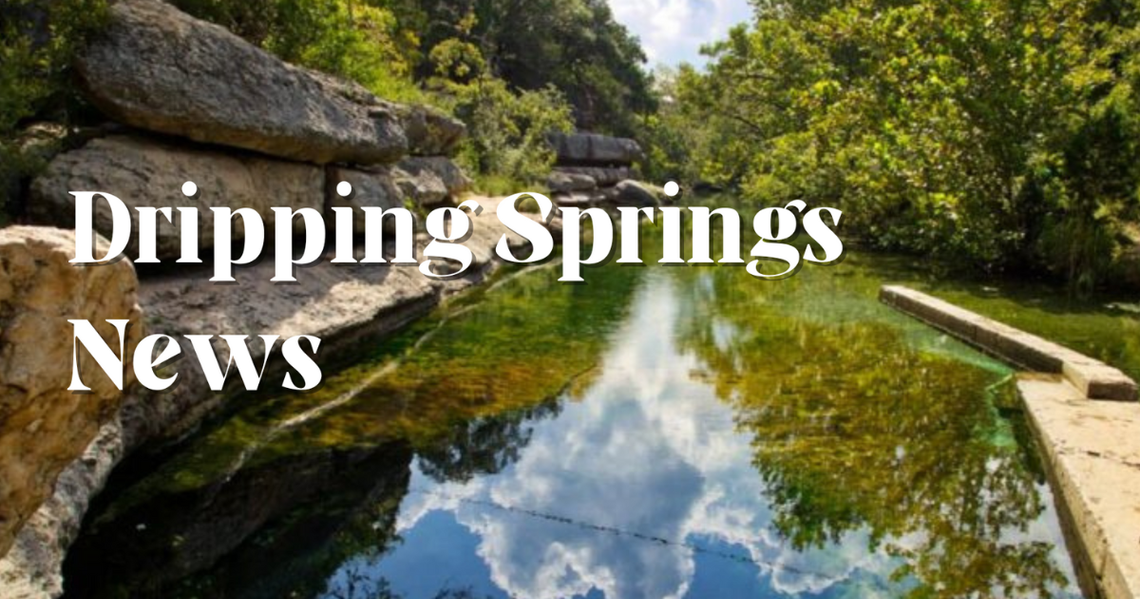DRIPPING SPRINGS — At its Aug. 5 meeting, Dripping Springs City Council held its fourth of several budget workshops, along with setting the proposed tax rate prior to its official public hearing.
Following presenting amendments made to the budget, deputy city administrator Shawn Cox explained that from FY 2021 to where the city anticipates FY 2026 to end, Dripping Springs will typically have a balance forward every year — this refers to the amount of unspent or overspent funds from the previous period.
“[We are] essentially living off of our savings, rather than that revenue we are bringing in annually to cover the annual costs. It’s not a problem, necessarily, to utilize your savings, as long as they are going toward capital projects and one-time expenditures and they are not recurring maintenance and operation costs,” Cox said.
Cox referenced that back in FY 21, the city started with a balance of $411,619.99 and ended the fiscal year with a balance of $1,942,847, adding $1,531,227.01 to the balance forward, which is more than what was anticipated at the beginning of the year.
“That is typical throughout our budget cycles. We get closer to the end of the year and that balance forward improves. I don’t anticipate that changing going into FY 26 and ending FY 27, but I don’t know that it’s going to change significantly enough that it’s going to offset how much of our savings we are using,” he said.
The city was adding to the fund balance in fiscal years 2021-23, but after 2024, the numbers started going down and the city started to use it. Now, it’s proposed that the starting balance for FY 26 to be $2,048,082.41, according to Cox’s presentation, and the ending balance at $154,667.95, essentially using $1.8 million of the city’s savings account to operate.
“Those projects and those years in FY 24 and 25, we were using them for one-time capital projects,” Cox explained. “When we see that we are utilizing those [funds], it’s not that we are not making the best use of the money. It’s just going into FY 26, we want to make sure we are not caught holding the bag at the end of the fiscal year.”
This specific discussion includes just the general fund and does not include the reserved funds, which is a separate fund and bank account, Cox clarified. The city will have approximately $3.5 million at the end of this fiscal year as a “rainy day,” or emergency, fund in the event that all revenue sources dry up for the city to operate on, he continued.
Dripping Springs Ranch Park
Dripping Springs Ranch Park (DSRP) and the utility fund were two major components of the budget workshop.
Lily Sellers, DSRP manager, explained to council that, in priority order, the following improvements are requested for the facility in the FY 26 budget:
Roof repairs and coating: $600,000
Daikin, or A/C, repairs: $98,000
Replace exterior facility lights: $27,250
Wash rack renovation project: $8,000
Restripe parking lots: $5,000
The major request from DSRP is to address the roof, which would include: removing 160 fiberglass skylights to replace them with metal sheeting; replacing all missing or loose screws and fasteners; repairing all holes and other damage; power washing entire roof; reinforcing and flashing in all horizontal seams, vertical laps and roof penetrations; and sealing roof with an elastomeric white coating.
Currently, the roof at DSRP is leaking substantially, Sellers said, therefore heavily impacting the rentals, programs and damaging relationships with repeat clients. The leaks are causing damage to the infrastructure and equipment, Sellers explained, adding that there could be even more issues in areas that are above insulated spaces that are not visible.
“Originally, this project was budgeted at $150,000 from previous quotes received, but within the past three years, it has increased substantially. This was something that was on our fiscal year 2025 [budget], but we were unable to accomplish it, due to the quotes that we received,” she said.
The roof also has holes, missing and loose screws, damaged panels and pooling that occurs when horizontal and vertical seams meet. The fiberglass skylights have worn paper thin and are posing a safety hazard, but are also the main culprit of the leaks, Sellers said. The skylights were vital to the building, but after the interior lighting was changed to LEDs, they are no longer needed.
DSRP has had to problem-solve during events because of the roof damage and leaking; for example, during the TX Junior Roller Derby New Years Tournament, they had to utilize tarps and buckets to redirect water off of the track.
“Events have come forward with safety concerns or damage toward their businesses or goods. Unfortunately, we cannot predict the rain before or during events and we are nearing towards the reality of being unable to rent major spaces until the leaks are addressed,” Sellers said.
Utilities
The highlights of revenue for the utilities fund include $1,675,000 in wastewater service fees, $900,000 in sales tax, $279,500 in right-of-way/franchise fees, $125,000 in water base rate and $275,000 in water usage, according to Cox.
As for the expenditures, Cox explained that for FY 26, some line items will be absorbed into other line items. For example, any expenditures paid from “chlorinator maintenance and alarm” are now being paid from routine maintenance, Cox said.
Additionally, for FY 2025, sludge hauling was budgeted at $165,000, but these costs are projected to end this fiscal year at $210,000, which will also be the amount that is requested for FY 2026. This increase is directly attributed to the higher flow volume at the plant and the addition of two new plants at the Arrowhead and Big Sky developments.
“When we were running our Arrowhead plant, when it was overloaded before our expansion there, we were hauling out of there three times a week because we didn’t have the same kind of detention time that we needed,” said utilities director Dane Sorenson. “Now that it’s only running at 50% capacity, those we are only hauling out of there maybe twice a month, so the higher the flow, the lower the detention time and that’s what’s allowing us to settle those solids out and pump that water back through the plant and not have to haul that off.”
A total of $50,000 has also been proposed for waste reuse operations, including system maintenance and repair at $20,000, along with routine operations, non-routine operations and irrigation all priced at $10,000 each, Cox said.
Tax rate
Each year, the city is required to set a proposed tax rate, which is the maximum that can be levied against properties within the Dripping Springs city limits.
“Just because we set a proposed tax rate at a specific amount does not mean that is the amount that council has to adopt when we come to voting on that tax rate. It is the maximum we could and that is why we are putting that amount in there for posting,” Cox said. “We could not post, per say, 17 cents and then, try to adopt at 18 cents, but we could post for 18 cents and then, adopt 17 cents.”
The proposed rate can include:
Maintenance and operations (M&O): Any lawful purpose other than debt service to which a taxing unit may spend property tax revenues.
Debt service or interest and sinking (I&S): The total amount expended, or to be expended, by a taxing unit from property tax revenue to pay principal of and interest on debts or other payments required by contract to secure the debts.
Historically, the city has adopted only the M&O rate, which covers the city’s routine maintenance and operation of the general fund, but staff also proposed a debt service rate. The I&S rate revenues could be deposited separately from the general fund and only used to pay any debt which qualifies, Cox said. Based on the Series 2024 and 2025 Debt Issuances, Cox said, the city will have approximately $900,000-$1,050,000 in debt payments from the general fund until FY 2030.
Council member Taline Manassian questioned if it would be unusual for the city to not have both the M&O and I&S rates.
“We looked at it because we had the cash flow and could do it and discussed we would evaluate an I&S rate as part of the budget process. So, this is the first year where you have a full recommendation from the finance department to at least propose that full I&S rate. Previously, we had discussed it, but then backed off on it when we went into the public notices,” Cox said. “Other cities I worked for have always adopted an I&S rate and it just services their debt.”
Council unanimously approved to set the proposed ad valorem tax rate at $0.2267 — consisting of the M&O rate at $0.184952 and the I&S rate at $0.04180 — which is an increase from the current rate of $0.1794.
To listen to the full Aug. 5 Dripping Springs City Council budget workshop, or to find more information on future meetings and agendas, visit www.drippingsprings-tx.municodemeetings.com.
Dripping Springs City Council will discuss the parks, farmers market, parkland dedication and parkland development budgets on Aug. 19. A public hearing for the tax rate will also be held Sept. 2.











